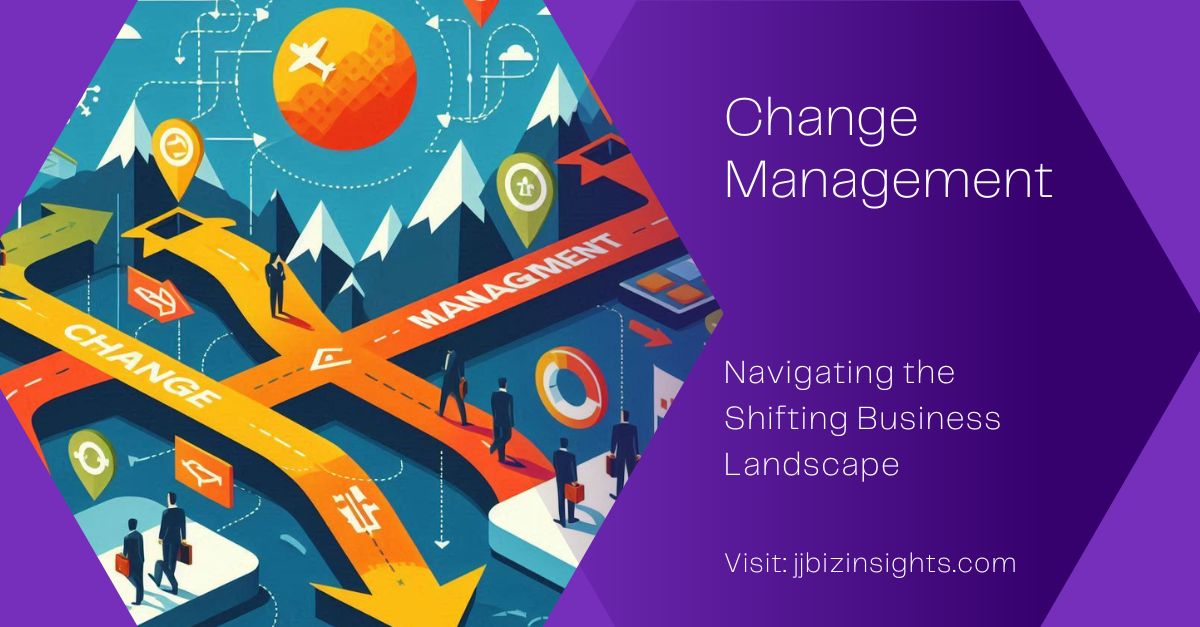
Change Management: Navigating the Shifting Business Landscape
The business world is in a state of perpetual motion. New technologies, market trends, and customer expectations emerge constantly, necessitating organizational adaptation. Effective change management is no longer a luxury but a necessity for survival and growth.
Understanding the Change Management Process
Change management is a systematic approach to dealing with the introduction of new ways of working within an organization. It involves planning, implementing, and evaluating the change process to minimize disruption and maximize benefits. The core stages of change management typically include:
- Initiating Change: Identifying the need for change, defining the desired outcomes, and building a compelling case for change.
- Planning and Preparing: Developing a detailed change management plan, including communication strategies, training programs, and resource allocation.
- Implementing Change: Executing the change plan, managing resistance, and providing support to employees.
- Evaluating and Sustaining Change: Assessing the impact of the change, measuring outcomes, and embedding the new processes into the organization’s culture.
Overcoming Resistance to Change
Resistance to change is a natural human reaction. Effective leaders must anticipate and address resistance to ensure a smooth transition. Strategies to overcome resistance include:
- Open Communication: Clearly communicate the reasons for change, the expected benefits, and the potential impacts.
- Employee Involvement: Involve employees in the change process to foster ownership and buy-in.
- Addressing Concerns: Acknowledge and address employees’ concerns and fears openly.
- Providing Support: Offer training, coaching, and mentoring to help employees adapt to the changes.
- Celebrating Successes: Recognize and reward achievements to reinforce the positive outcomes of change.
Building a Change-Ready Culture
A change-ready culture is one where employees embrace change as an opportunity for growth and development. To foster such a culture:
- Empower Employees: Give employees autonomy and decision-making power to encourage innovation.
- Encourage Learning and Development: Invest in employee training and development to equip them with the skills to adapt to change.
- Celebrate Failures: Create a psychologically safe environment where failures are seen as learning opportunities.
- Lead by Example: Demonstrate flexibility and adaptability in your own behavior.
The Role of Technology in Change Management

Technology can be a powerful tool for managing change. It can facilitate communication, collaboration, and knowledge sharing. Some key technologies include:
- Change management software: To track progress, manage communication, and measure outcomes.
- Collaboration tools: To foster teamwork and knowledge sharing.
- Learning management systems: To deliver training and development programs.
Conclusion
Change management is a complex process that requires careful planning, effective communication, and strong leadership. By understanding the key stages of change, addressing resistance proactively, and building a change-ready culture, organizations can successfully navigate the challenges of transformation and emerge stronger.
How to foster a Change-Ready Culture in your Organization?
Fostering a change-ready culture in your organization involves creating an environment where employees are adaptable, resilient, and continuously learning. Here are some strategies to help you achieve this:
1. Empower Employees
- Autonomy and Decision-Making: Give employees the freedom to make decisions and take ownership of their work. This encourages innovation and a sense of responsibility.
- Encourage Innovation: Create a supportive environment where new ideas are welcomed and mistakes are seen as learning opportunities.
2. Promote Continuous Learning and Development
- Training Programs: Invest in regular training and development programs to keep employees’ skills up-to-date.
- Learning Opportunities: Encourage employees to pursue further education and professional development.
3. Foster Open Communication
- Transparent Communication: Keep communication channels open and transparent. Regularly update employees on organizational changes and the reasons behind them.
- Feedback Mechanisms: Implement systems for employees to provide feedback and voice their concerns.
4. Lead by Example
- Demonstrate Adaptability: Show flexibility and adaptability in your own behavior. Leaders should model the change-ready mindset they wish to see in their teams.
- Proactive Leadership: Communicate a compelling vision for change and provide clear direction. Encourage open and transparent communication.
5. Build Resilience
- Supportive Environment: Create a culture where failures are seen as opportunities for growth. Encourage resilience by supporting employees through challenges.
- Recognition and Rewards: Recognize and reward achievements to reinforce positive outcomes and motivate employees.
6. Encourage Collaboration and Teamwork
- Cross-Functional Teams: Promote collaboration across different departments to break down silos and foster teamwork.
- Knowledge Sharing: Encourage the sharing of knowledge and best practices among employees.
7. Utilize Technology
- Change Management Software: Use tools to track progress, manage communication, and measure outcomes.
- Collaboration Tools: Implement tools that facilitate teamwork and knowledge sharing.
Conclusion
Building a change-ready culture is an ongoing process that requires commitment from both leaders and employees. By empowering your team, promoting continuous learning, fostering open communication, leading by example, building resilience, encouraging collaboration, and leveraging technology, you can create an environment that not only withstands change but thrives in it.
Common Challenges Organizations face when trying to build a Change-Ready Culture
Building a change-ready culture can be challenging for many organizations. Here are some common obstacles they might encounter:
1. Resistance to Change
- Natural Human Reaction: Employees often resist change due to fear of the unknown, loss of control, or concerns about their ability to adapt.
- Overcoming Resistance: Effective communication, involving employees in the change process, and addressing their concerns can help mitigate resistance.
2. Lack of Leadership Support
- Crucial Role of Leaders: Without strong leadership buy-in, efforts to build a change-ready culture can falter. Leaders need to model the desired behaviors and support change initiatives.
- Leadership Buy-In: Leaders should demonstrate a willingness to embrace change, communicate a clear vision, and empower their teams.
3. Inadequate Communication
- Importance of Clear Communication: Poor communication can lead to misunderstandings, rumors, and resistance. Clear, transparent, and consistent communication is essential.
- Effective Communication Strategies: Regular updates, open forums for discussion, and feedback mechanisms can enhance communication.
4. Lack of Employee Engagement
- Engagement is Key: Engaged employees are more likely to embrace change and contribute positively to the process.
- Fostering Engagement: Providing opportunities for feedback, recognizing contributions, and involving employees in decision-making can boost engagement.
5. Deeply Ingrained Norms and Culture
- Challenging Existing Norms: Long-standing organizational norms and culture can be difficult to change.
- Cultural Transformation: It requires a concerted effort to shift mindsets and behaviors, often starting with leadership and cascading down.
6. Change Fatigue
- Excessive Change: Continuous or poorly managed change initiatives can lead to change fatigue, where employees feel overwhelmed and exhausted.
- Managing Change Fatigue: Prioritizing changes, providing adequate support, and recognizing the impact on employees can help manage fatigue.
7. Lack of Resources
- Resource Allocation: Insufficient resources, whether financial, human, or technological, can hinder change efforts.
- Ensuring Adequate Resources: Proper planning and allocation of resources are crucial for successful change management.
8. Disconnect Between Strategy and Culture
- Alignment Issues: A misalignment between the organization’s strategy and its culture can lead to wasted efforts and hinder change initiatives.
- Strategic Alignment: Ensuring that cultural initiatives align with the overall business strategy is essential for coherence and effectiveness.
Conclusion
Addressing these challenges requires a comprehensive approach that includes strong leadership, effective communication, employee engagement, and strategic alignment. By recognizing and proactively managing these obstacles, organizations can build a resilient, change-ready culture that thrives in a dynamic business environment.
Some Real-World examples of Organizations with strong Change-Ready Cultures

Here are some real-world examples of organizations known for their strong change-ready cultures:
1. Microsoft
Microsoft has undergone significant transformations under CEO Satya Nadella’s leadership. The company shifted from a “know-it-all” to a “learn-it-all” culture, emphasizing continuous learning and adaptability. This change has been pivotal in Microsoft’s resurgence and innovation.
2. Google
Google fosters a culture of innovation and flexibility. The company encourages employees to spend 20% of their time on projects they are passionate about, which has led to the development of successful products like Gmail and Google News. Google’s open communication and collaborative environment support its change-ready culture.
3. Netflix
Netflix’s culture is built on the principles of freedom and responsibility. The company trusts its employees to make decisions and encourages them to take risks. This approach has enabled Netflix to adapt quickly to changes in the entertainment industry and maintain its competitive edge.
4. Adobe
Adobe has embraced a culture of continuous improvement and innovation. The company encourages experimentation and learning from failures. Adobe’s commitment to employee development and open communication has helped it navigate industry changes effectively.
5. Airbnb
Airbnb promotes a culture of belonging and inclusivity. The company values employee feedback and fosters an environment where everyone feels empowered to contribute. This inclusive culture has been crucial in helping Airbnb adapt to market changes and expand globally.
6. GitLab
GitLab operates with a fully remote workforce and has built a culture of transparency and collaboration. The company uses extensive documentation and open communication to ensure everyone is aligned and can adapt to changes quickly. GitLab’s remote-first approach has made it highly adaptable to the evolving work environment.
7. Pixar
Pixar’s culture emphasizes creativity and collaboration. The company promotes psychological safety, allowing employees to share ideas without fear of judgment. This culture of radical candor and teamwork has been key to Pixar’s success in producing innovative and beloved films.
8. Chewy
Chewy, an online retailer for pet products, has created a positive work environment with professional development opportunities, team member resource groups, and flexible work arrangements. This supportive culture helps Chewy adapt to changes and maintain high employee engagement.
Conclusion
These organizations demonstrate that a strong change-ready culture involves continuous learning, open communication, employee empowerment, and a willingness to embrace innovation. By fostering these elements, companies can navigate the shifting business landscape and thrive in the face of change.





